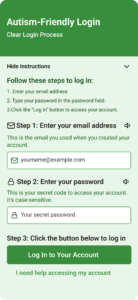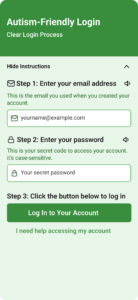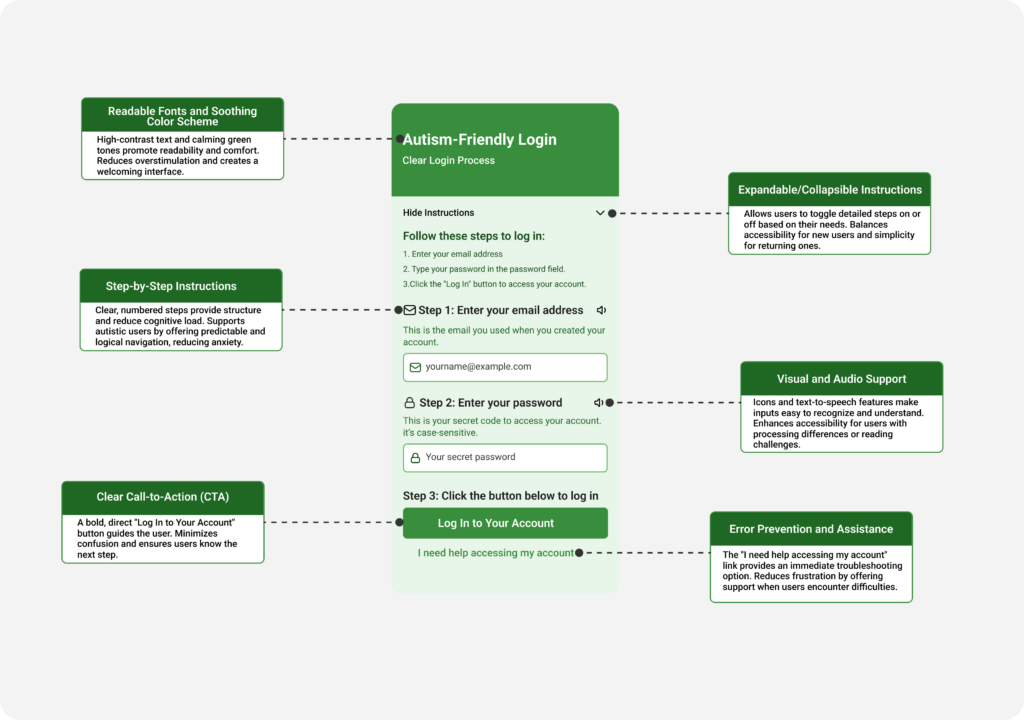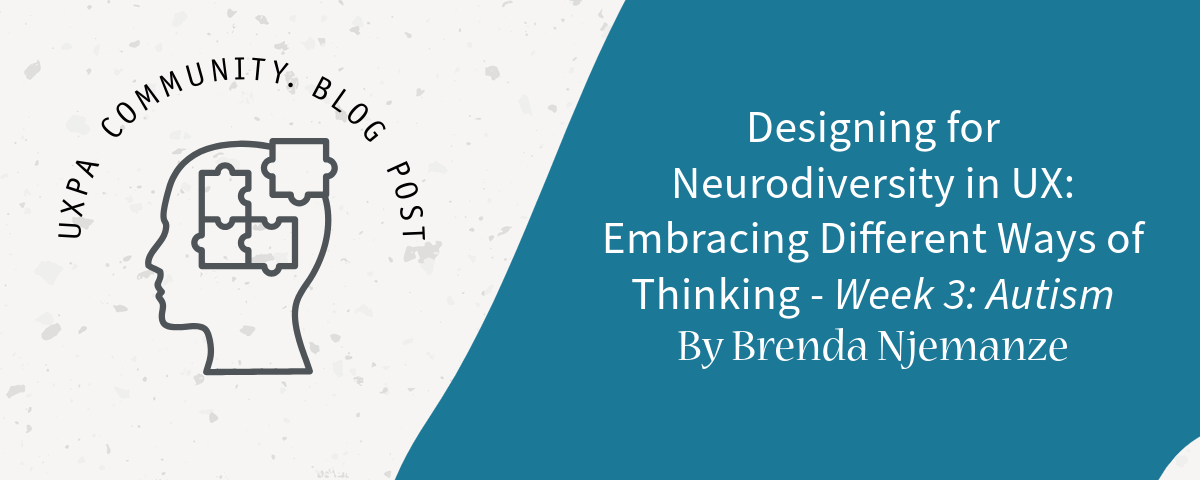Welcome to insights and stories from our wonderful UXPA Community! This new blog series is dedicated to showcasing our members and interesting UX topics. Our goal is to bring together various viewpoints from fellow UXers all over the globe. If you’d like to participate, please email volunteers@uxpa.org.
Designing for Neurodiversity in UX: Embracing Different Ways of Thinking
Imagine if the digital world didn’t look the same for everyone, but worked differently based on how our minds navigate it. For millions of neurodiverse people using technology can feel like solving a puzzle with pieces that don’t quite fit — whether it’s the constant distractions of ADHD, the reading struggles of dyslexia, or the sensory overload often faced by autistic individuals. While traditional approaches to accessibility tend to focus on physical and sensory needs, there’s another crucial aspect we need to talk about: cognitive diversity.
In this series, we’re exploring how UX design can better embrace the different ways people think and experience the online world. We’re not just going to discuss theories; we’ll look at real examples and practical strategies to make digital experiences more inclusive. Our focus will be on three conditions — ADHD, dyslexia, and autism — each with unique challenges and opportunities for more thoughtful design.
Meet Our Characters
To make this more than just abstract ideas, we’ll follow the stories of three individuals: Sarah, who lives with ADHD; Alex, who has dyslexia; and Emma, who is autistic. Their experiences will help us see digital interfaces through their eyes and understand how small changes in design can make a big difference in making the online world feel a little more welcoming.
Designing for Autism in UX - A Clear Pathway
Imagine being in a room where every object is trying to get your attention. The lights flicker, the air conditioner hums loudly, and it feels like everything is demanding you to focus on it at once. For someone on the autism spectrum, this is what navigating some digital spaces can feel like — sensory overload paired with uncertainty. The solution? Clear, predictable design that reduces stress and creates an easier path for interaction.
Meet Emma, a young adult on the autism spectrum who relies on technology every day. While digital tools help her stay organized, many apps and websites leave her feeling overwhelmed. She needs clear instructions, simple layouts, and interfaces that feel consistent and calm. This week, we’re looking at how thoughtful design can create a welcoming space for Emma and others like her.
What Autism Teaches Us About Digital Design
Autism Spectrum Disorder (ASD) affects how people process sensory information, communicate, and interact with the world. For someone like Emma, a cluttered website or a process with too many steps can feel confusing and frustrating. She thrives on clarity, predictability, and simplicity.
Emma’s experience reminds us that every element in a design carries weight. Instructions that are hard to follow or visual layouts that feel too busy can create barriers for her. However, with some simple adjustments, we can make these interactions stress-free and empowering.
Emma's Ideal Login Experience
When Emma opens the Autism-Friendly Login page, it’s immediately calming and structured. The steps are simple and clear:
- She sees step-by-step instructions explaining exactly what to do. If she's familiar with the process, she can hid the instructions to simplify the screen.
- Each input field, like email and password, is labeled clearly and includes helpful icons for context.
- As she interacts with the page, real-time feedback reassures her that she's doing everything correctly. For example, an audio cue can confirm her entry if she clicks the speaker icon.
- The overall design is minimal and calming, avoiding unnecessary elements or distracting animations.
- Finally, the "Help" button is easy to spot, but doesn't overwhelm her. It's there when she needs it, without being intrusive.


Figure 1. Autism-Friendly Login with the Focus Mode On
Figure 2. Autism-Friendly Login with the Focus Mode Off
Designing With Autism in Mind
To create digital experiences that work for users like Emma, we need to focus on clarity, predictability, and reducing sensory overload. Here’s how we can design an autism-friendly login interface:
- Step-By-Step Instructions
Think of unclear instructions as walking into a room with no signs, leaving you unsure of where to go. Providing step-by-step guidance, with each task clearly outlined, is like placing directional signs at every corner, giving users confidence and reducing anxiety. - Collapsible Instructions
For users who don’t need extra help, too many instructions can feel overwhelming. A collapsible option allows users to hide or show guidance as needed, like offering a map that can be folded away once the path is clear. - Consistent Icons and Labels
Ambiguous or inconsistent visuals can be confusing, like encountering road signs in a language you don’t understand. Using familiar icons (e.g., an envelope for email, a lock for password) and clear labels ensures every element is instantly recognizable. - Sensory-Friendly Design
Bright, flashing elements or unexpected sounds can feel like a sensory overload. Using calm colors, avoiding unnecessary animations, and providing control over autoplay features is like dimming the lights and softening the noise in a busy room — creating a more comfortable environment. - Predictable Layouts
A cluttered, ever-changing interface is like a maze that keeps shifting its walls. A clean, predictable layout with consistent placement of elements gives users a sense of stability and familiarity, helping them navigate with ease.
By designing with these principles, we create spaces where users like Emma can feel calm, confident, and in control. Thoughtful, autism-friendly designs aren’t just helpful — they’re empowering.

Figure 3. Designing for Autism Using the 5 Steps
Making the Digital World Inclusive
Designing for autism isn’t about making everything plain or basic — it’s about creating clarity, reducing anxiety, and giving users more control. By rethinking even simple processes like logging in, we can make the digital world feel less daunting and more accessible for everyone.
Have you ever designed something for autistic users? Or, considered how features like step-by-step guidance might help? Share your experiences or ideas — I’d love to hear how you’re working toward more inclusive designs. Let’s keep building digital spaces that work for everyone, no matter how they navigate the world.
About Brenda
I’m a Product Designer who found my passion for design after earning a Master’s in Business Information Technology from Northumbria University Newcastle. With over 5 years of experience in product and project management, I’ve always been drawn to solving complex problems and creating impactful solutions. That journey led me to UX design where I discovered the perfect balance of strategy, creativity, and empathy.
My work spans industries like fintech and AI-powered property management where I focus on crafting intuitive, human-centered solutions. I’m also exploring how emerging technologies like AI can shape more inclusive and accessible designs.
For me, design is about empathy and curiosity — understanding people and creating experiences that make a difference. Whether it’s rethinking workflows or championing inclusivity, I’m committed to delivering meaningful, human-centered solutions.
Resources
To learn more about Neurodiversity and Autism, here are some helpful resources.
Fessenden, T. (Host). (2024, August 23). UX accessibility and designing for neurodiversity (feat. Stéphanie Walter) (No. 41) [Video podcast episode]. In NN/g UX Podcast. NNgroup. https://www.youtube.com/watch?v=VgwitYuGP7Y
Friedman, V. (2023, August 23). How to Design for Autistic People. Smart Interface Design Patterns. https://smart-interface-design-patterns.com/articles/design-autism/
Pun, K. (2016, September 2). Dos and don’ts on designing for accessibility. Gov.UK. https://accessibility.blog.gov.uk/2016/09/02/dos-and-donts-on-designing-for-accessibility/
Rusakova, I. (2020, October 29). Designing for autistic people — Overview of existing research. Medium: UX Collective. https://uxdesign.cc/designing-for-autistic-people-overview-of-existing-research-d6f6dc20710e
Sutterlin, K. (2023, September 7). How to design for neurodiversity: Inclusive content and UX [Webinar]. Interaction Design Foundation. https://www.interaction-design.org/master-classes/how-to-design-for-neurodiversity-inclusive-content-and-ux


